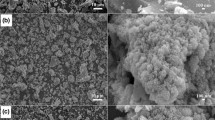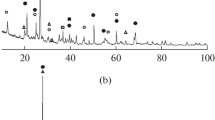Abstract
Titanium in TiO2 minerals was differentiated from that isomorphously substituted into minerals by the use of dihydrogen hexafluorotitanate (hydrofluotitanic acid, H2TiF6), which selectively dissolved minerals containing substituted Ti4+, leaving free crystalline TiO2 minerals in the residue. Titanium analyses on the original samples and the residues remaining after H2TiF6 treatment, by both wet chemical (Tiron) and neutron activation methods, indicated that an average of 86 per cent of the titanium in seven kaolinite samples was present in the residual TiO2 form (largely anatase), whereas only 28 per cent in two bentonites was present in the TiO2 form. Residual Ti accounted for 100 per cent of the Ti in synthetic anatase and for 92 per cent of the Ti in coarse clay sized rutile, the latter value suggesting that about 8 per cent amorphous TiO2 was removed from the mechanically dry ground rutile by the H2TiF6 reagent. The Ti present as residual TiO2 in a variety of other samples ranged from 0 to 100 per cent.
Résumé
Le titanium dans les minéraux TiO2 a été différencié de cleui substitué de maniøre isomorphe aux minéraux, par l’emploi de dihydrogøne hexafluorotitanate-2 (acide hydrofluotitanique, H2TiF6), qui a dissout d’une maniøre sélective les minéraux contenant du Ti4+ subsitué, en laissant libre les minéraux TiO2 cristallins dans le résidu. Des analyses de titanium sur les échantillons originaux et les résidus restant aprøs le traitement H2TiF6, à la fois par un procédé chimique humide (Tiron) et d’activation de neutrons, ont montré qu’il y avait une moyenne de 86% du titanium dans sept échantilons de kaolinite, sous la forme résiduelle de TiO2 (en grande pattie l’anatase), alorsqu’il se trouvait seulement 28% dans deux bentonites sous la forme de TiO2. Le Ti résiduel représentait 100% du Ti dans l’anatase synthétique et 92% du Ti dans de l’argile grossier taillé rutile, la derniøre valeur suggérant qu’environ 8% de TiO2 amorphe étaient enlevés du rutile broyé à sec mécaniquement, par le réactif H2TiF6. La présence de Ti en tant que TiO2 résiduel en une variété d’autres échantillons variait de 0 à 100%.
Zusammenfassung
Titanium in TiO2 Mineralen wurde von isomorph in Mineralen substituiertem durch Verwendung von Dihydrogen Hexafluorotitanat-2 (Hydrofluotitansäure. H2TiF6) unterschieden die Minerale, die substituiertes Ti4+ enthielten, selektiv löste, unter Zurücklassung von freien, kristallinen TiO2 Mineralen im Rückstand. Titananalysen an den ursprünglichen Proben und den nach H2TiF6 zurückbleibenden Resten, sowohl durch nass-chemische (Tiron) als auch durch Neutronaktivierungsmethoden, zeigten, dass durchschnittlich 86% des Titaniums in sieben Kaolinitproben in der residuellen TiO2 Form (hauptsächlich Anatas) vorhanden war, während nur 28% in zwei Bentoniten in der TiO2 Form auftrat. Residuelles Ti stellte im synthetischen Anatas 100% des Ti dar und 92% des Ti in grobem, Tongrösse-Rutil, wobei der letztere Wert andeutet, dass durch das H2TiF6 Reagenz etwa 8% amorphes TiO2 aus dem mechanisch trocken gemahlten Rutil entfernt worden sind. Das als residuelles Ti in einer Anzahl anderer Proben vorhandene Ti bewegte sichin einem Bereich von 0 bis 100%.
Абстракция
Титан минералов состава TiO2 может быть отделен от титана, образующего изоморфные примеси, при использовании гексафтортитановой кислоты H2TiF6; эта кислота селективно растворяет минералы, содержащие изоморфную примесь Ti4+ оставляя неизмененными кристаллические минералы TiO2. Определения титана как в необработанных природных образцах, так и в остатках после обработки H2TiF6; проведенные методом химического анализа мокрым путем и нейтроно-активационным методом, показали, что в среднем 86% титана в семи каолинитовых образцах содержится в виде остаточного минерала TiO2 (главным образом, в виде анатаза), тогда как в двух образцах бентонита только 28% титана представлено свободной TiO2. На долю остаточного титана приходится 100% Ti в синтетическом анатазе и 92% Ti в рутиле грубой глинистой фракции; предположительно около 8% Ti аморфного TiO2 удаляется из механически растертого в сухом состоянии рутила с помощью H2TiF6. Содержание Ti в виде остаточного TiO2 в ряде других образцов колеблется от 0 до 100%.
Similar content being viewed by others
References
Chapman, S. L., Syers, J. K., and Jackson, M. L. (1969) Quantitative determination of quartz in soils, sediments and rocks by pyrosulfate fusion and hydrofluosilicic acid treatment: Soil Sci. 107, 348–355.
Deer, M. A., Howie, R. A., and Zussman, J. (1962) Rock-Forming Minerals, Vol. 5. Non-Silicates, p. 37. Wiley, New York.
Dempster, P. B., and Ritchie, P. D. (1952) Surface of finely-ground silica: Nature 169, 538–539.
Fukamauchi, H. (1967) Analysis using fluorotitanic acid-hydrogen peroxide reagent: Fresenius’ Z. Anal. Chem. 229, 413–432. Chem. Abstr. 67, 96451e.
Jackson, M. L. (1958) Soil Chemical Analysis. Constable, London.
Knowles, E. C., Kay, E. L., and McCoy, F. C. (1966) Amine hexafluorotitanate multipurpose lubricant additives: Chem. Abstr. 65, 18404c.
Mankin, C. J., and Dodd, C. G. (1963) Proposed reference illite from the Ouachita Mountains of southeastern Oklahoma: Clays and Clay Minerals 10, 372–379.
Raman, K. V., and Jackson, M. L. (1965) Rutile and anatase determination in soils and sediments: Am. Mineralogist 50, 1086–1092.
Roth, C. B., Jackson, M. L., and Syers, J. K. (1969) Deferration effect on structural ferrous-ferric iron ratio and CEC of vermiculites and soils: Clays and Clay Minerals 17, 253–264.
Sherman, G. D. (1952) The titanium content of Hawaiian soils and its significance: Soil Sci. Soc. Am. Proc. 16, 15–18.
Sherman, G. D., Matsusaka, Y., Ikawa, H., and Uehara, G. (1964) The role of the amorphous fraction in the properties of tropical soils: Agrochimica 8, 146–163.
Weaver, C. E. (1968) Electron microprobe study of kaolin: Clays and Clay Minerals 16, 187–189.
Weiss, A., and Range, K. J. (1966) Über Titan im Gitter von Kaolin: Proc. Intern. Clay Conf. (Jerusalem) 1, 53–66.
Yoe, J. H., and Armstrong, A. R. (1947) Colorimetric determination of titanium with disodium-1,2-dihyroxy-benzene-3,5-disulfonate: Anal. Chem. 19, 100–102.
Author information
Authors and Affiliations
Additional information
Research Assistant, Assistant Professor and Professor, respectively
Rights and permissions
About this article
Cite this article
Dolcater, D.L., Syers, J.K. & Jackson, M.L. Titanium as Free Oxide and Substituted Forms in Kaolinites and other Soil Minerals. Clays Clay Miner. 18, 71–79 (1970). https://doi.org/10.1346/CCMN.1970.0180202
Received:
Published:
Issue Date:
DOI: https://doi.org/10.1346/CCMN.1970.0180202




